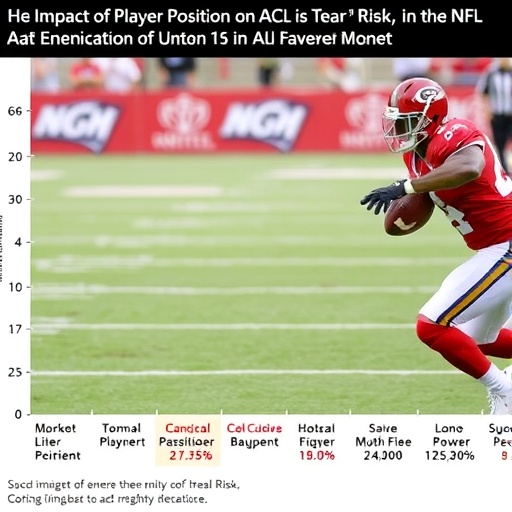
A groundbreaking study from the University of Missouri School of Medicine has shed new light on the risk factors surrounding anterior cruciate ligament (ACL) injuries among National Football League (NFL) players, emphasizing the increased vulnerability of wide receivers and tight ends. This research meticulously analyzed a decade’s worth of data from the 2012-13 through 2022-23 NFL seasons, highlighting the nuanced dynamics that underpin such debilitating knee injuries. ACL tears are among the most severe injuries an athlete can suffer, often necessitating surgical reconstruction and extensive rehabilitation, with many players facing uncertain prospects of returning to their previous performance levels.
The anterior cruciate ligament plays a pivotal role in stabilizing the knee joint, particularly by preventing excessive rotational movements that could compromise joint integrity. In high-impact sports like professional football, where players are frequently subjected to abrupt directional changes and high-velocity collisions, the ACL endures extreme stresses. Wide receivers and tight ends, tasked with rapid acceleration, deceleration, and intricate route-running, engage in movements that impose considerable strain on the knee ligament. This biomechanical demand places these players at an inherently higher risk for ACL injury, as confirmed by the Missouri study.
Intriguingly, ACL injuries occur through both contact and non-contact mechanisms. Of the 520 ACL tears documented in the study, nearly half were attributed to contact-related incidents, including tackles and collisions with other players or obstacles on the field. Conversely, approximately one-third of the injuries were due to non-contact mechanisms such as pivoting, sudden stops, or awkward landings after jumps. These findings underscore the complexity inherent in preventing ACL injuries, as both extrinsic and intrinsic factors converge to influence injury risk.
.adsslot_4I9JjwMdFb{width:728px !important;height:90px !important;}
@media(max-width:1199px){ .adsslot_4I9JjwMdFb{width:468px !important;height:60px !important;}
}
@media(max-width:767px){ .adsslot_4I9JjwMdFb{width:320px !important;height:50px !important;}
}
ADVERTISEMENT
Contrary to previous assumptions, the research did not reveal significant differences in injury rates between natural grass and artificial turf surfaces. Historically, artificial turf was considered more culpable due to its increased rigidity, potentially exacerbating joint stress and injury risk. However, advances in the design, composition, and maintenance of turf fields may have equalized these conditions. Modern turf installations now better mimic natural grass in terms of impact absorption and traction, possibly mitigating previous disparities in injury incidence.
The temporal distribution of ACL injuries further illuminated patterns that could inform preventive strategies. The study observed a disproportionately high number of tears early in the football season, with 291 incidents occurring before week nine. Moreover, a stark contrast emerged between game-time injuries and those sustained during practice, with 352 injuries happening in games compared to 168 in practice sessions. This timing suggests that the heightened intensity, speed, and unpredictability of live games dramatically elevate ligament stress and injury risk.
Understanding the pathophysiology of ACL tears necessitates a grasp of the ligament’s structural role within the knee. The ACL resists anterior translation of the tibia relative to the femur and guards against rotational forces that might compromise the joint. When an athlete plants their foot and executes a sharp pivot or experiences an awkward valgus force during a tackle, these forces may exceed the ligament’s tensile threshold, resulting in a partial or complete tear. Surgical reconstruction often requires harvesting grafts and meticulous rehabilitation, as the native ACL does not typically heal effectively on its own.
The psychological and economic tolls BCof ACL injuries on NFL players cannot be overstated. Prolonged rehabilitation periods—typically nine months or more—challenge not only physical endurance but also mental resilience, often impacting players’ career trajectories and contract negotiations. As Dr. Clayton Nuelle, the study’s lead author and an orthopedic surgeon specializing in sports medicine, emphasizes, identifying modifiable risk factors is critical in formulating injury prevention protocols that could save careers and reduce long-term morbidity.
This extensive epidemiological study also benefits from the multidisciplinary expertise of its authors. In addition to Dr. Nuelle, the research team included medical students, residents, and several renowned orthopedic specialists whose combined insights enhanced the robustness of data interpretation and clinical relevance. Their collective efforts have amplified understanding of ACL injury epidemiology in professional football, laying groundwork for future research and intervention.
One of the study’s salient implications is the need to reassess training programs and field regulations tailored to high-risk positions like wide receivers and tight ends. Conditioning regimens that emphasize neuromuscular control, proprioception, and strength may mitigate stress on the ACL during dynamic movements. Moreover, in-game tactics could be refined to reduce exposure to potentially injurious contacts and awkward landing situations, integrating biomechanics research into practical sports medicine applications.
Emerging technology in sports analytics and wearable sensors offers promising avenues to monitor individual players’ biomechanical patterns in real time, potentially alerting coaching staff and medical teams to heightened injury risks before they culminate in ligament damage. Such innovations could revolutionize preventive strategies and shift the paradigm from reactive to proactive care in professional football.
Additionally, advances in surgical techniques and postoperative rehabilitation protocols have improved outcomes for athletes who suffer ACL tears, but the optimal strategy remains controversial and patient-specific. The findings of this study further emphasize the importance of personalized medicine approaches, considering the unique biomechanical and positional demands placed on each player.
Finally, this research underscores the essential role of ongoing surveillance and data collection in understanding sports injuries. As turf technologies evolve, training methodologies advance, and medical treatments improve, continuous epidemiological studies will be pivotal in tracking injury trends, guiding policy decisions, and ultimately safeguarding athlete health at the highest levels of competition.
Subject of Research: People
Article Title: Anterior Cruciate Ligament Injuries in National Football League Players from 2012 to 2022: A Descriptive Epidemiology Study
News Publication Date: 23-Jul-2025
Web References: https://medicine.missouri.edu/ ; http://dx.doi.org/10.1055/a-2652-2567
References: Nuelle, C. W., Garlapaty, A., Kluge, M., Blankenship, Q., Parola, R., Njai, A., Stannard, J., Bischoff, C., Cook, J. L., DeFroda, S. F. (2025). Anterior Cruciate Ligament Injuries in National Football League Players from 2012 to 2022: A Descriptive Epidemiology Study. The Journal of Knee Surgery.
Keywords: Femur, Tibia, Sports medicine, Orthopedics, Physical exercise
Tags: ACL tear risk factors in NFL playersanterior cruciate ligament functionbiomechanical strain in footballhigh-impact sports knee injuriesimpact of player position on ACL injuriesNFL injury statistics analysisNFL player injury prevention strategiesnon-contact ACL injury mechanismsrehabilitation after ACL surgerysports medicine research findingstight ends injury vulnerabilitywide receivers and ACL injuries




